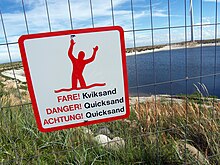Quicksand


Quicksand is a mixture of water and sand or silt. It has the characteristic of thixotropy: it looks solid, but when pressure is applied it liquifies (acts like a liquid). If animals or people stand on it, they sink into it. However, a person does not drown in quicksand. A human or animal does not sink entirely into quicksand due to the higher density of the fluid.[1] It can be difficult to get out: that is the real problem. Quicksand may be escaped by slow movement of the legs in order to reduce viscosity of the fluid, and rotating the body so as to float on one's back (supine).[2]
Water circulation underground can focus in an area with just the right mixture of fine sands and other materials such as clay. The water moves up and then down slowly in a convection-like manner throughout a column of sand, and the sand remains a generally solid mass. This lubricates the sand particles and makes them unable to support any significant weight, since they move around with very little friction. They behave more like a liquid when exposed to stress. Since the water does not usually go all the way up through the sand, the sand above does not appear to move at all, and can support leaves and other small debris. This makes it difficult to distinguish quicksand from the surrounding environment.
Properties[change | change source]
Quicksand is a non-Newtonian fluid: when undisturbed it often seems to be solid ("gel" form), but a small (less than 1%) change in the stress on the quicksand causes it to turn liquid ("sol" form). There is a sudden decrease in its viscosity. Under his weight, the person then sinks into the sol (liquidised sand).
Someone stepping in it starts to sink. Around the person dense regions of sand and sediment form and grip the person. The viscosity of the quicksand seems to increase suddenly. It is now a gel. In order to move within the quicksand, a person or object must apply sufficient pressure on the compacted sand to re-introduce enough water to liquify it. The forces required to do this are quite large: to remove a foot from quicksand at a speed of one centimeter per second would require the same amount of force as "that needed to lift a medium-sized car".[3][4]
It was commonly believed that the behavior of quicksand was due solely to saturated or supersaturated suspensions of granules in water. Pressure from underground sources of water would separate and suspend the granular particles, reducing the friction between them. In 2005 it was been shown that the presence of salt is important. The stability of the colloidal quicksand is changed by the presence of salt. It increases the high viscosity regions of sediment responsible for quicksand's "trapping" power. Another finding was that a human cannot be drawn into a saltwater quicksand entirely.[3][4]
Prevalence[change | change source]

Quicksand may be found inland (on riverbanks, near lakes, or in marshes), or near the coast.
One region notorious for its quicksands is Morecambe Bay, Yorkshire. As the bay is very broad and shallow, a person trapped by the quicksand would be exposed to the danger of the returning tide, which can come in rapidly.
References[change | change source]
- ↑ The science is: objects in liquefied sand sink to the level at which the weight of the object is equal to the weight of the displaced soil/water mix and the submerged object floats due to its buoyancy.
- ↑ Bakalarfor, Nicholas (2005). "Quicksand science: why it traps, how to escape". National Geographic News. Retrieved October 9, 2011.
- ↑ 3.0 3.1 A. Khaldoun, E. Eiser, G.H. Wegdam and Daniel Bonn 2005. Rheology: Liquefaction of quicksand under stress Nature 437, 635 doi:10.1038/437635a
- ↑ 4.0 4.1 Bakalarfor, Nicholas (2005). "Quicksand science: why it traps, how to escape". National Geographic News. Retrieved October 9, 2011.
